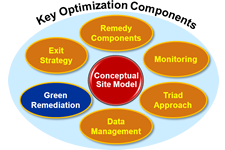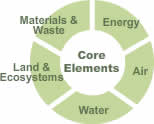Overview
Key Optimization Components: Green Remediation
 The EPA’s definition of Green Remediation is:
The EPA’s definition of Green Remediation is:
“The practice of considering all environmental effects of remedy implementation and incorporating options to minimize the environmental footprint of cleanup activities.”
It considers five core elements:
- Energy - reducing total energy use and increasing the percentage of energy from renewable resources
- Air - reducing air pollutants and greenhouse gas emissions
- Water and water resources - reducing water use and negative impacts on water resources
- Materials and waste management - improving materials management and waste reduction efforts
- Land and ecosystems - protecting ecosystem services during site cleanup

Green Remediation qualitative and quantitative evaluations is now a standard component of optimization technical support. To find more information about Green Remediation principles, practices and methods, please visit EPA�s website and the CLU-IN website listed in the resources below.
Selected Resources
Click on a column heading to sort the table. Search for additional publications or resources by keyword or topic using the Search page.
| Title | Document Number | Type | Date | |
|---|---|---|---|---|
| Remediation Optimization: Definition, Scope and Approach | EPA 542-R-13-008 | General Publication | 2013 | |
| CLU-IN Website - Green Remediation Focus | N/A | Online Resources | 2014 | |
| Superfund Website - Superfund & Green Remediation | N/A | Online Resources | 2014 |




